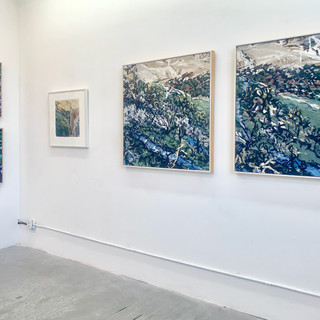Artist Interview with Mimi Oritsky
- amoseno
- Nov 7, 2019
- 3 min read
Interview with Mimi Oritsky on the occasion of her solo exhibition Soft Wet to Hard Dry on view at Amos Eno Gallery, October 24 - November 17, 2019
AEG: I was reading your statement about your work as a depiction of “space organized by light and a surface marked by the rhythm of the moving air.” What else can you say about movement in your paintings? Mimi Oritsky: The movement in my paintings is probably most important. When I was teaching on a regular basis, my students brought this factor to my attention. Several remarked that from a distance, they could see imagery that was somewhat recognizable. Upon moving closer to my paintings, they saw my "marks" that I made to create the images but were in fact very abstract. So, two things were going on at the same time: My involuntary "marks" were working together to create the "whole" painting that appeared "together" from afar. My subconscious automatically created "movement". The difficult thing is retaining this quality in my work while attempting to wrap it up. Therefore, I must pay close attention to what I've done versus what I need to do to accomplish a whole statement. I always appreciate people that can live w/my work, seeing something different each time they look at it. AEG: Yes, I am always amazed by how each mark has a unique abstract quality that seems to operate independently of what it represents. The same mark can stand in as a twig in one painting or as an entire tree in another painting. How does your approach to mark making change from one subject to the next? MO: My approach to mark making does NOT change from one subject to another. As stated previously, "marks" have been unconscious at each moment (rather than voluntary). In other words, I do not make conscious "marks". They work together to create the "whole" image. They change from the viewer's standpoint from far away to up close. AEG: Can you tell us more about the tension between wholeness/togetherness and abstraction? How is that your marks hang together? MO: The tension between wholeness/togetherness & abstraction evolves on their own to create a whole that makes sense for abstraction plus representation. I suppose that if they didn't work, I would ERASE & start over. I do have a process for that. I do "trash" more than I save. In other words, it may take 15 paintings to find the sections to save. I am aware of this creative process. It can take hours or days of re-evaluation which is very important to my work. AEG: What time of day do you like to re-evaluate a work?
MO: I like to re-evaluate my work in both the early evening and very early morning. My evaluation process involves Looking at my work in terms of both ?does it work as a whole? And does it have the. Intensities & drama that I had set out to do. ? AEG: What role does drawing play in your practice? AEG: It’s nice to see drama in painting that does not depict human suffering. MO: Yes, the drama in my painting does not depict human suffering. Rather, “drama” was a word that my Mother used to describe my work. She was an illustrator for Harper's Bazaar during WWII. Her work was commercial ART in fine line drawing. I took a different route w/fine art. My Mother describes my work with “drama” I believe because of my heavy marks and lines With thick paint & charcoal & conte. AEG: Yes, that there can be drama in nature is wonderfully engaging. It's interesting that your Mother was doing illustrative drawing. Your work explores the powerful nature of representation that pushes past representation into the world of expressive abstraction. What has more intensity- an aerial view or a close up perspective? MO: BOTH have equal intensity for me! My Father used to take me up in the airplane (w/him to work) where I could look down and out simultaneously, while my Mother took me to the top of the Empire State Bldg. where I could look down (w/the wind). Since they have passed, I've been working in wooded areas where I get more close-up views. Again, both vantage points have equal intensity for me. Today (actually), I've been reviewing my pastels from Las Vegas Nevada where I did both viewpoints. I halted their construction because a former classmate told me that their "dust" would harm me. NOW, I am excited to return to pastels as my drawings look more expressive to me than my paintings. Probably because they are more immediate?? I don't really know, but I will give it a shot!





























